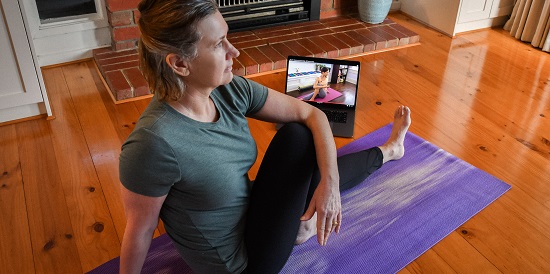App based exercise becomes answer to fitness woes during lockdown
Media release
A national study into how people maintained their physical activity during last year's pandemic restrictions has revealed digital platforms are an effective way to help people stay fit when access to other forms of organised exercise is restricted.
Baseline findings from the longitudinal Our Life at Home study led by Dr Kate Parker and Dr Lauren Arundell from Deakin University's Institute for Physical Activity and Nutrition (IPAN) found that people who used digital platforms to access facilitated classes or online and app-based fitness programs were more likely to meet physical activity guidelines than those who didn't.
Dr Parker said the Australian study of 1188 adults and 963 adolescents during the first national lock-down last year confirmed that digital platforms can play a critical role in supporting physical activity when more traditional services such as gyms, personal trainers and fitness studios are closed or have reduced capacity.
"We found that 39 per cent of adults used digital platforms and they were more than twice as likely to meet the moderate to vigorous intensity physical activity guidelines set by the World Health Organization and the Australian Government, and more than three times more likely to meet the muscle strengthening guidelines," Dr Parker said.
"They were also nearly three times more likely to meet the combined guidelines compared to non-users."
Dr Parker said that facilitated sessions on platforms such as YouTube, Facebook and Instagram were appealing because they were often free to use, readily accessible and presented a broad range of exercise options.
"We found that women and adults in paid employment were more likely to use digital platforms for exercise. This probably reflects the types of activities more commonly used by women, such as yoga and dance, are very adaptable to online environments and are accessible any time of the day or night and regardless of the weather."
Dr Parker said she was pleased to see 26 per cent of teenagers benefitting from using digital platforms.
"Adolescents who used digital platforms were more than twice as likely to meet the moderate to vigorous intensity physical activity guidelines of an hour a day, more than three times more likely to meet the muscle strengthening guidelines of three or more times a week, and more than four times more likely to meet the combined guidelines compared to non-users," Dr Parker said.
Dr Parker said digital platform users were also highly likely to meet muscle strengthening guidelines because the exercises use bodyweight activities that don't need specialised equipment and are easily performed in confined spaces such as the home.
"These results show that there is a real opportunity for relevant government or non-government organisations to make use of these platforms for education, instruction and promotion of physical activity to the general public."
Dr Parker said further research as part of the Our Life at Home study would look at whether these adaptive changes became entrenched preferences and continued to keep people active during the various waves of COVID-19 restrictions being experienced in different states in Australia.

